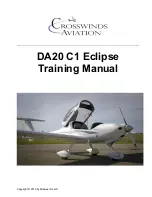
Aircraft Operating Instructions (AOI)
Type:
CT
Series:
CTLS
LSA
Page: 8-3
AU 010 11000
Revision No. 4
Date: 29 Apr 2008
8.4. Cleaning and care
A modern aircraft made of composite materials must be cleaned with caution.
Numerous cleaning agents have been developed especially for certain materials and
can indeed cause damage to others. Using the wrong cleaning agent can damage
your aircraft or parts of it. This damage may be visible or not directly detectable.
Damage can take the form of simple flaws or can impair the structure. It is thus
essential that you check the ingredients of a cleaning agent before use. If in doubt,
contact your local Flight Design service station.
Warning:
High-pressure washer equipment should never be used to clean the
aircraft!
8.4.1. Airframe
Many components of composite aircraft are sandwich constructions comprising a
foam core and layers of glass fiber, carbon fiber or aramid fiber. The CTLS is made
from a carbon or aramid sandwich and is painted with a two-component polyurethane
paint.
The Rohacell foam core used for the wings was chosen for its fuel durability.
However, Rohacell is not resistant to alkaline liquids. For this reason, no alkaline
cleaning agents such as Fantastic, Formula 409, Carbonex or Castrol Super Clean
should be used. These alkaline cleaning agents can cause the Rohacell foam core to
disintegrate if they penetrate to the core. A rippled surface is an indication of such
disintegration. Components damaged in this way cannot be repaired and have to be
replaced.
The wing spars of the CTLS cannot be damaged in this way.
Products from the ComposiClean series which has been specially developed for
aircraft made of composite materials are approved as cleaning agents. Each CTLS
leaves the factory with a basic set of this cleaning agent series.
8.4.2.
Windshield and windows
The windshield and windows of the CTLS are made of perspex (plexiglass, acrylic
glass) which was formed at high temperatures. Although perspex is very robust, it
must be cleaned with care to ensure that it is not scratched. Never use abrasive
cleaning agents or dirty cloths. Usually the windshield and windows can be cleaned
using lots of clean water. However, if dirt is stubborn, perspex cleaning agents only
should be used.
Only use special perspex polish for the windshield and windows. Never polish in a
circular movement, always in straight lines (up and down or from side to side). This
prevents the occurrence of the disturbing halo effect caused by circular scratches.
Light scratching can usually be polished out by your Flight Design service station.
Make sure that you never leave solvent-soaked cleaning cloths under the windshield
or near the windows. Vapors can quickly lead to small stress cracks in the glass. A
windshield or windows damaged in this way cannot be repaired and must be
replaced.








































